Free converting forms worksheets with answer key. No login or account needed. From converting fractions to decimals, numeric to word and everything in between, we've got you covered. A grading column and quick grade scale maker grading a breeze and a modified pages help with lower level learners or when just introducing a topic. Great for teachers or for homeschool.
Browse Sheets By Problem Type
×
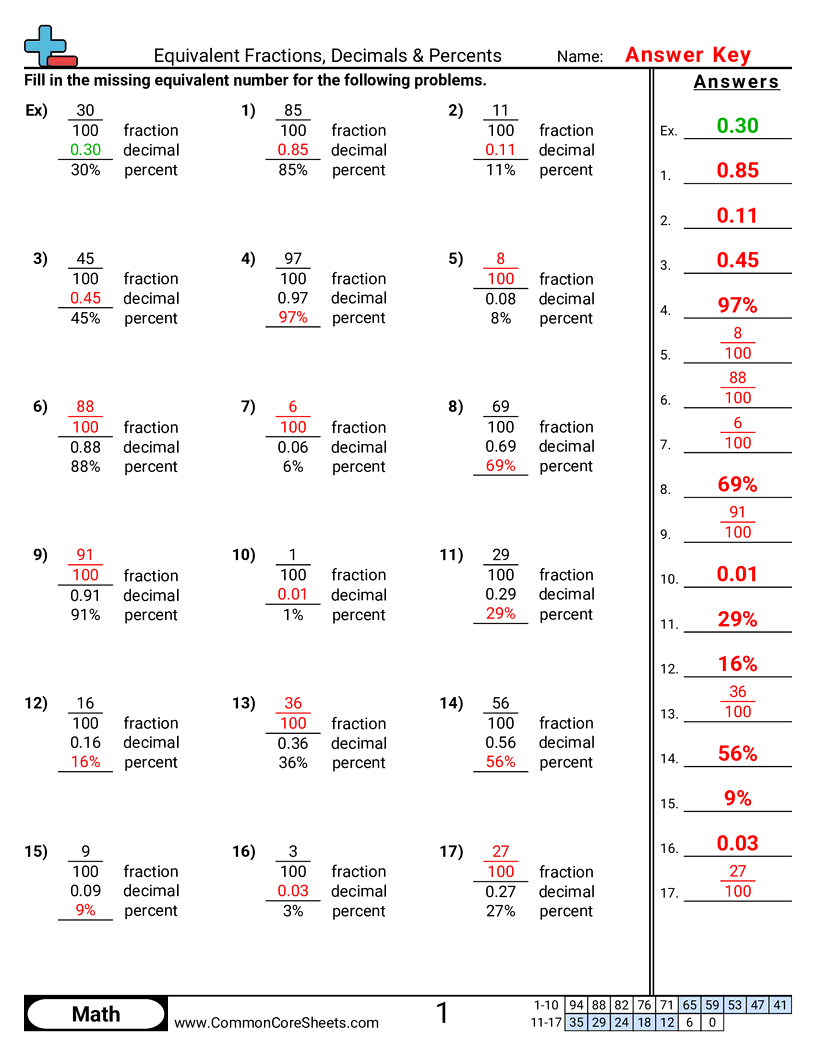
4nf6


×
Description:
"This worksheet is designed to aid in understanding the relation between fractions, decimals, and percentages. With 17 problems, it gives children hands-on practice in converting between these equivalent forms of numbers. Highly customizable, the worksheet can be adapted to fit different learners' needs, successfully converted into flashcards, or seamlessly integrated into distance learning curricula, providing an engaging tool to enhance math proficiency."

×
Student Goals:
Master the concept of equivalent fractions, decimals and percentagesAfter completing this worksheet, students should have a thorough understanding of the concept of equivalency among fractions, decimals, and percentages. They should be able to seamlessly convert a value from one form to another, showing a solid understanding of the integral relationships between these three mathematical representations.Develop computational skillsThis practice will foster students' computational skills, necessary for more advanced mathematical procedures. They would be well-versed with calculations involving the transition from fractions to decimals to percentages and vice-versa, enhancing their ability to calculate quickly and accurately.Promote problem-solving abilityBy working through the problems in this worksheet, students will improve their problem-solving skills. They will learn how to approach and solve complex problems involving fractions, decimals, and percentages. This practice will encourage critical thinking and logical reasoning, fundamental skills that are used in everyday life and other academic subjects.Amplify number senseCompletion of this worksheet will enhance students' number sense. It would promote a deeper understanding of the nature of numbers and their relationships, particularly in the context of fractions, percentages, and decimal values. This translates into improved mathematical intuition and a swift sense for number manipulation.Improve precision and attention to detailHandling fractions, decimals, and percents would help students fine-tune their precision and heighten their attentiveness to detail. As comprehension of these topics demands meticulous calculation and exactness, students will strengthen these qualities through consistent practice.Boost confidence in mathSuccessfully completing this worksheet means not only understanding the relationship between fractions, decimals, and percentages but also being adept at manipulating them. This mastery can result in greater confidence while facing math problems, which can in turn encourage a positive mindset towards learning new mathematical concepts.


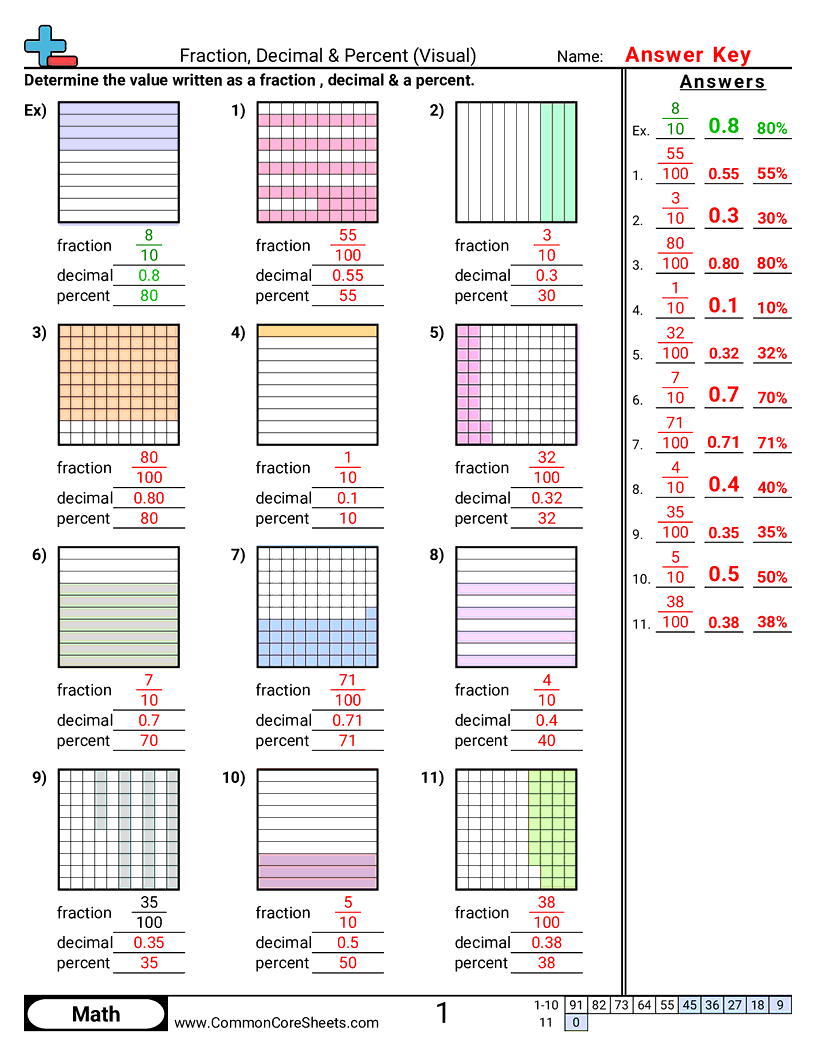
4nf6


×
Description:
"This worksheet is designed to enhance children's understanding of the correlation between fractions, decimals, and percentages using clear visual aids. It offers 11 unique problems, enabling students to apply their learned concepts practically. Educators can customize this versatile resource, creating flashcards for a more interactive experience or integrating it into distance learning curricula. This focused approach aids in building a solid foundation for more complex mathematical concepts."

×
Student Goals:
Understanding of Basic Mathematical RepresentationStudents should demonstrate a solid grasp of basic mathematical representation by successfully completing each problem in the worksheet. This includes understanding fractions, decimals, and percentages, and their relations. They should be able to confidently convert fractions to decimals and percentages, and vice versa, thus displaying proficiency in manipulating different mathematical forms.Mathematical Literacy DevelopmentBy the completion of the worksheet, students should have improved their mathematical literacy. They're set to have deepened their understanding of mathematical concepts and terminology, especially those pertaining to fractions, decimals, and percentages. A boosted level of mathematical literacy will make them better at quickly recognizing and processing mathematical patterns, which is a key skill that will benefit them in future advanced mathematical endeavors.Analytical Skills EnhancementAfter engaging with the worksheet, students are expected to have enhanced their analytical skills. By navigating from fractions to decimals to percentages, and correlating their common value, students will have strengthened their analytical thinking. This is a critical skill not just in mathematics but in problem-solving in other academic spheres and real-life situations. It helps develop an independent thinking process that is essential to make them successful learners.Comprehension of Practical ApplicationsUpon completion, students are projected to appreciate the practical applications of what they have learnt. Fractions, decimals, and percentages are not just theoretical mathematical concepts; they come to life in many everyday scenarios. Whether it's managing personal finances, planning baking recipes, or analyzing sports statistics, these concepts are widely used. Understanding them can thus empower students to navigate their everyday life more effectively.Confidence in Mathematical AbilitiesFinally, students should gain enhanced confidence in their mathematical abilities. Successfully solving these exercises will give them a strong sense of achievement and boost their academic confidence. This belief in their own capabilities will motivate them to approach more challenging mathematical problems in the future with less fear and more determination. In learning, confidence is key, and through mastering this worksheet, students are setting up a positive foundation for all future learning.


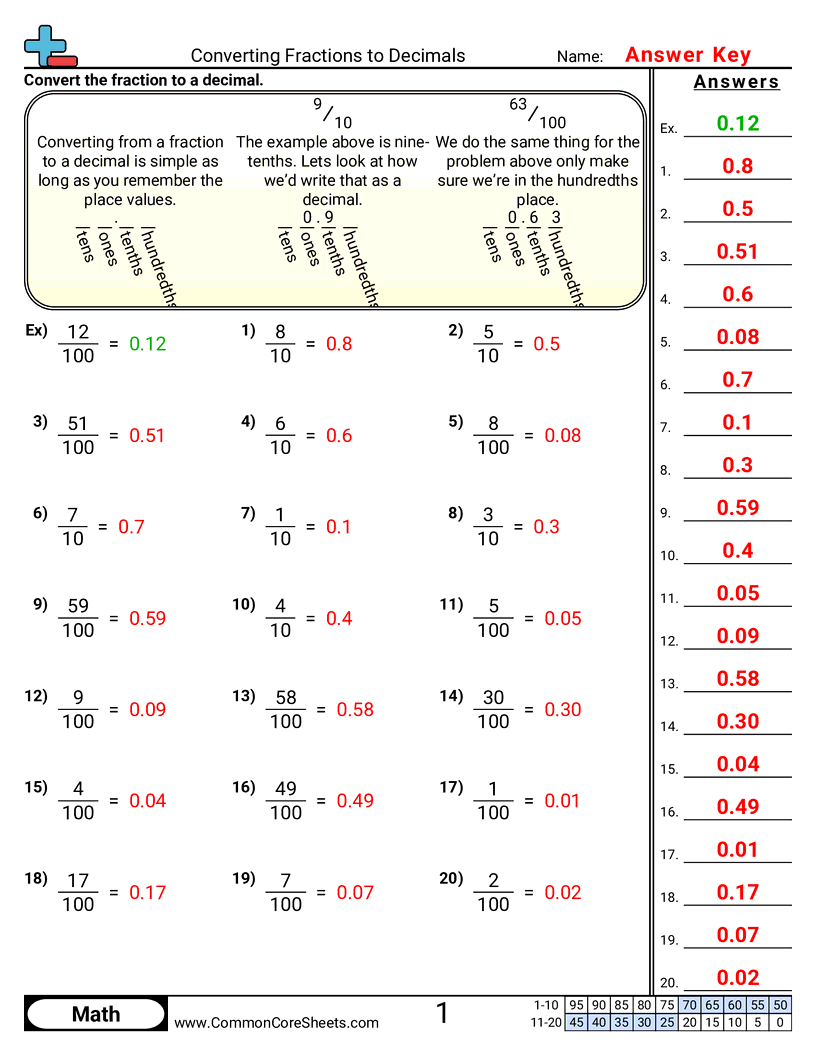
4nf6


×
Description:
"This worksheet is designed to help children master the concept of converting fractions to decimals in a fun, engaging way. It offers 20 math problems where kids convert typical fractions into their decimal equivalents. Its interactive format offers adaptability and can be customized to suit individual learning needs. It could even be transformed into flash cards for additional practice or used in a distance learning environment to ensure continuous and effective learning."

×
Student Goals:
Understanding Fractions and DecimalsAfter completing the worksheet, students will have a clear understanding of how fractions and decimals are related. They will be able to effortlessly convert fractions to decimals and will know the underlying process behind it. This fundamental knowledge will allow them to navigate more complex math problems with ease.Mastery of Arithmetic SkillsBy practicing with twenty problems, students will achieve mastery in the arithmetic required to convert fractions into decimals. Their computation skills, coupled with an understanding of the place-value system used in decimals, will be significantly improved, enhancing their overall mathematical capabilities.Improved Problem-Solving SkillsThis worksheet is designed to foster mathematical inquiry, encouraging students to independently solve problems. After successful completion, they will have improved their problem-solving skills, which can be applied to other math topics and real-world scenarios.Boost in Mathematical ConfidenceBy successfully converting fractions to decimals, students will experience a significant boost in confidence, making them more likely to engage with mathematical topics in the future. This essential trust in their abilities can contribute positively to their overall academic performance.Preparation for Advanced Mathematical ConceptsThe knowledge of converting fractions to decimals is an integral part of more advanced mathematical concepts like algebra, percentage calculations, and data interpretation. Therefore, after completing the worksheet, students will be well-prepared for tackling these advanced topics when they encounter them.Enhancement of Analytical SkillsThe process of converting fractions to decimals involves step-by-step logical reasoning. As students navigate through these steps, they enhance their analytical skills — a trait that’s not only important in mathematics, but also beneficial in other subject areas and in everyday life.


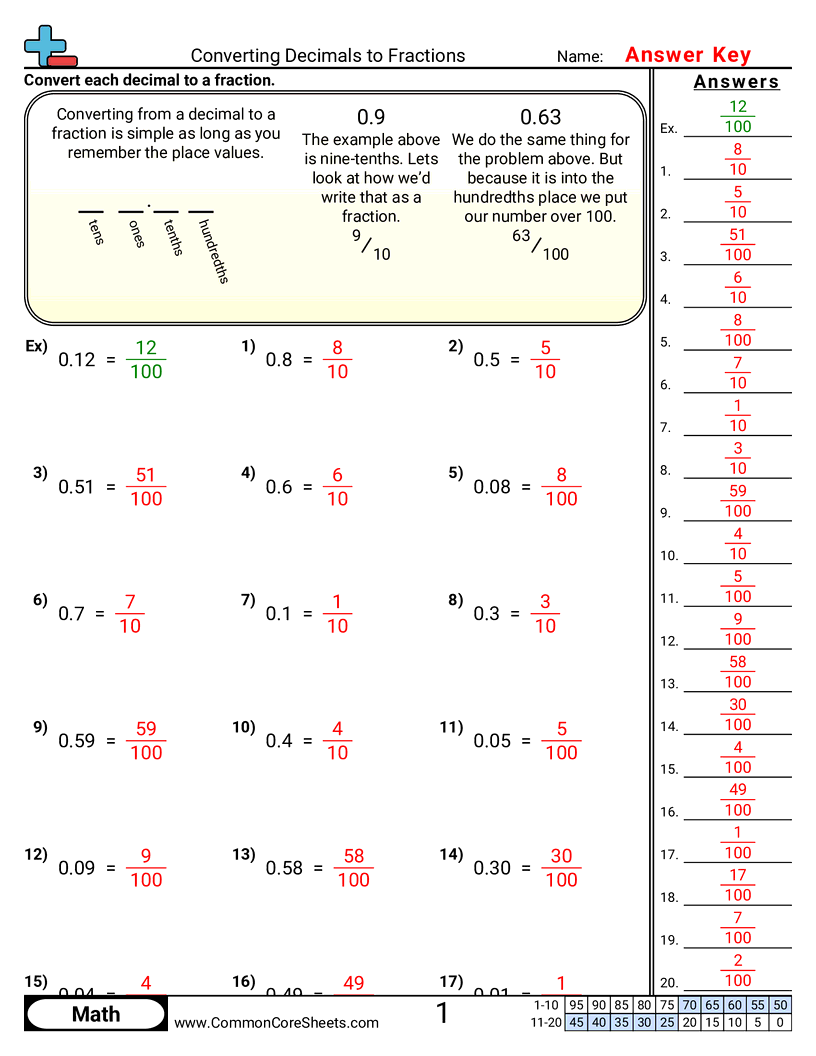
4nf6


×
Description:
"This worksheet is designed to instruct students on the subject of mathematics, specifically converting decimals to fractions. With 20 problems that visualize decimal values equaling to fractions, it provides engaging examples and practical exercises. Flexible for any learning environment, this worksheet is customizable, can be effortlessly converted into flash cards, and is suitable for distance learning, making it an adaptable educational resource."

×
Student Goals:
Understanding of Decimals and FractionsAfter completing the worksheet, students will have a firm understanding of decimals and their corresponding fractions. They should grasp the important concept that fractions and decimals are just two different ways of expressing the same value. This understanding provides a strong foundation for more advanced mathematical concepts.Conversion SkillsThe completion of the worksheet will equip learners with the necessary skills to convert decimals into fractions effortlessly. They will understand the systematic process involved in transforming a decimal into both its reduced and non-reduced fraction forms. This skill is central to many aspects of mathematics and is crucial for subsequent learning stages.Enhanced Problem-Solving AbilitiesWorking through the problems on this worksheet requires logical reasoning and problem-solving skills. The students will be better at diagnosing the problem, understanding the steps it takes to solve it, and applying this approach to different, yet similar problems. These enhanced abilities extend well beyond mathematics and are beneficial to all other subjects.Confidence in MathematicsSuccessfully converting decimals to fractions can boost the confidence of the learners. Building assurance in their mathematical abilities will encourage them to tackle more challenging problems without fear of failure. This confidence is pivotal in stimulating a positive attitude towards mathematics and other numeracy-based subjects.Preparation for Advanced MaterialThe ability to convert decimals to fractions is important in higher mathematical contexts such as algebra, geometry, and calculus. By honing these skills now, students will be better prepared to manage future mathematical coursework. This worksheet sets the groundwork for these critical, more advanced mathematical concepts.Real-World ApplicationThe ability to convert decimals to fractions has many practical, real-world applications, including but not limited to understanding scientific data, making accurate financial decisions, or even dividing recipes in cooking. By mastering this skill, students will be able to handle numbers in various real-life situations more efficiently.


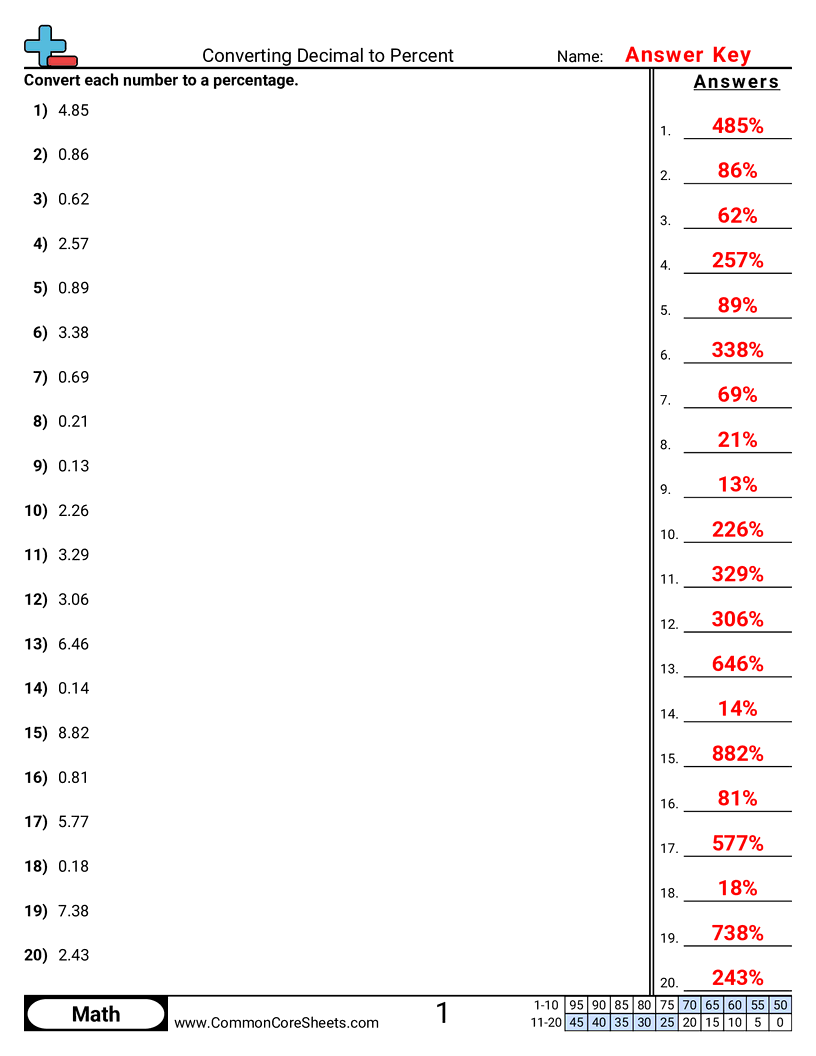


×
Description:
"This worksheet is designed to enhance children's understanding of mathematics by teaching them how to convert decimals into percentages. With 20 individual problems varying in complexity, it offers diverse practice opportunities. The resource can be customized according to the learner's needs, perfect for distant learning or conversion into flashcards for on-the-go review and retention. It forms a comprehensive aid for solidifying core math skills."

×
Student Goals:
Understanding Decimals and PercentagesUpon successfully completing these exercises, students should have solidified their understanding of the relationship between decimals and percentages. This foundational skill is crucial for more advanced mathematical concepts and real-world applications. Understanding the connection is a big step toward numerical literacy.Conversion SkillsThis worksheet provides ample opportunity for students to practice converting decimals to percentages, an important skill in various aspects of practical and theoretical mathematics. Following completion, students should be proficient in this conversion process, able to confidently translate decimal numbers into percentages, enhancing their overall mathematical capabilities.Enhanced Math ProficiencyAfter working through these problems, students should experience enhanced overall math proficiency. Comprehending the structure and mechanics of numerical systems and how they interrelate is an essential part of developing mathematical competency. The exercises will help pave the way for students to tackle more complex mathematical tasks.Problem Solving AbilitiesBy solving these problems, students will improve their overall problem-solving abilities. Because each problem requires careful consideration and precise calculation, students should develop better discipline and focus, along with a systematic approach to problem-solving, which can be beneficial across other subjects and daily scenarios.Increased Numerical ConfidenceFinally, students should experience an increase in their numerical confidence upon completing the worksheet. Repeatedly practicing such conversions and receiving immediate feedback on their progress helps to boost students' self-confidence in their abilities. This enhanced self-belief can be hugely beneficial in encouraging students to tackle even more challenging mathematical concepts in the future.


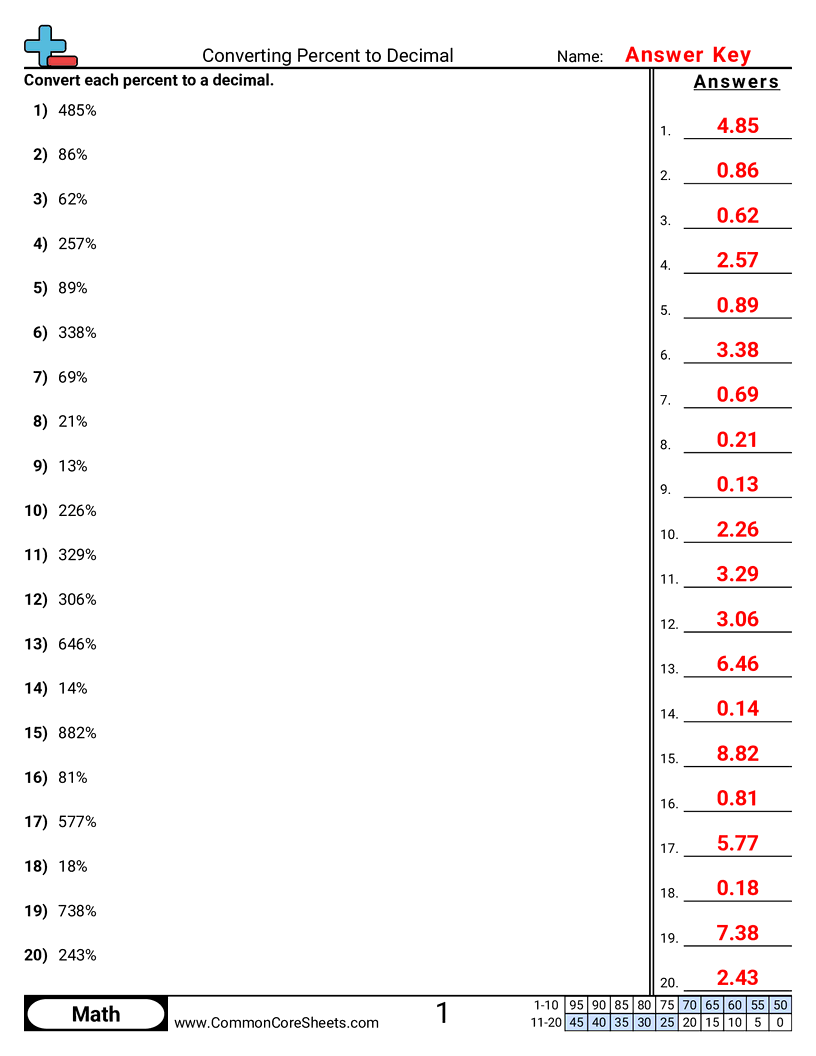


×
Description:
"This worksheet is designed to strengthen children's math skills by teaching them to convert percentages to decimals in a simple, intuitive format. It offers 20 different problems, ranging from 5% to 925%, to ensure comprehensive understanding. Versatile and adaptable, this worksheet can be customized, transformed into flashcards for visual learners or even employed in distance learning settings. A perfect resource for educators or parents seeking a targeted method to upgrade math proficiency."

×
Student Goals:
Understanding of Percentages and DecimalsAfter completing this worksheet, students will have cultivated a stronger understanding of percentages and their decimal equivalents. This fundamental math skill is a building block for many different formulas and concepts in math, finance, and scientific calculations. Understanding how to convert percentages into decimals gives students a more versatile mathematical toolbox so they can adapt to different types of problems and scenarios.Enhanced Computational SkillsUpon completion of the worksheet, students will have enhanced their computational skills. Conversion of percentage to decimals encompasses basic arithmetic operations like division and multiplication, whetting students' arithmetic skills. These computations not only help students build accuracy but also speed in solving problems.”Problem-Solving CompetenceThrough working on this worksheet, students will develop improved problem-solving competencies. Converting percentages to decimals is more than a rote process; it encourages logical and strategic thought. Every percentage poses a unique challenge for students to solve, thereby boosting their decision-making skills and ability to apply their knowledge in solving diverse problems.Confidence in Math ProficiencyStudents will gain confidence in their math proficiency by completing this worksheet. Each correct answer serves to reinforce their understanding of the topic and builds their self-assurance in tackling similar tasks in the future. Confidence plays a crucial role in fostering a positive attitude towards complex mathematical concepts, thereby enabling students to face more advanced learning with resilience.Preparation for Advanced Mathematical ConceptsFinally, mastering the conversion of percentages to decimals arms students with an essential skill required in advanced mathematical concepts. This familiarity paves the way for topics like algebra, calculus, statistics, and real-world applications like interest rates and ratio comparisons. Therefore, completion of this worksheet is a stepping stone towards more in-depth mathematical discourse.


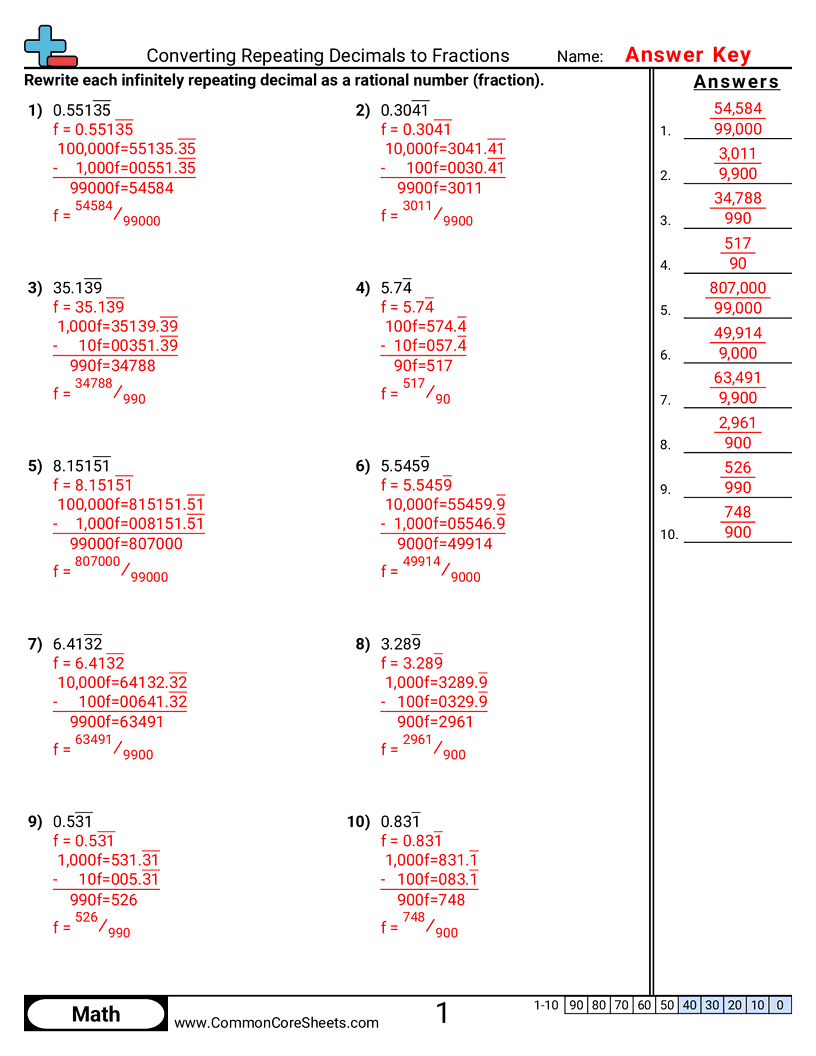
8ns1


×
Description:
"This worksheet is designed to enhance children's math skills specifically in converting repeating decimals to fractions. With ten clearly outlined problems, children can dive into the concept of repeating decimals with examples like 3.83, 43.26, and 0.6319. This customizable learning tool accommodates various teaching methods, making it perfect for flashcards or distance learning modalities. It combines the power of visual aids and hands-on exercises for an engaging learning experience."

×
Student Goals:
Understanding ConceptsAfter completing the worksheet, students should gain a comprehensive understanding of the concept of converting repeating decimals to fractions. They should be able to recognize and differentiate repeating decimals and use the appropriate steps to convert them into fractions.Problem Solving SkillsThe completion of the worksheet should enhance the students’ problem-solving skills. They should be able to apply mathematical methods proficiently in solving the problems. This experience could help promote their confidence in handling similar problems in the future.Mathematical FluencyBy solving the problems provided in the worksheet, students should improve their mathematical fluency. They will actively practice and apply the learnt concept, which will assist in solidifying their skills and knowledge in math, particularly in the topic of fractions and decimals.Critical ThinkingThis worksheet should help improve the students’ critical thinking abilities. In solving the problems, they will need to think analytically and strategically. They will also learn how to approach problems from different angles, further enhancing their critical thinking skills.Application of KnowledgeUpon completion of the worksheet, students should be in a position to apply the knowledge gained in real-world situations. Understanding decimals and fractions is essential in many everyday contexts, such as shopping and time keeping. This worksheet provides a foundation for such application of knowledge.Independence in LearningWorking through this worksheet should help students develop independence in their learning process. The ability to decipher the problems and find solutions by themselves will likely improve their confidence and autonomy in learning not just math, but other subjects as well.








